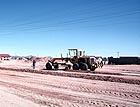Recycled Land Put to Good Use
Some councils are successfully building large numbers of new homes on previously developed land, benefiting the British countryside says the CPRE.


The countryside can breathe a sigh of relief, thanks to a government initiative to build new homes on previously developed brownfield land. Government figures show that 15 councils have achieved a land recycling level of 95% with just one new home in every 20 being built on a greenfield site. The Campaign to Protect Rural England (CPRE) is currently campaigning hard to prevent proposed changes in Government planning guidance, weakening the 'brownfield-first' approach of recent years. Over the last four years Watford has achieved a record 100% land recycling figure with Epsom and Ewell close behind on 99%. Meanwhile Worcester was the most improved area ? raising the level of recycled land from 15% to 81%. 'We warmly congratulate these councils,? said Henry Oliver, CPRE's Head of Planning and Local Government. ?We're delighted that there has been such strong progress across the country by council planners and developers in raising the level of land recycling and getting away from wastefully low densities for new housing. 'Together, these improvements in land recycling and density have saved thousands of acres of countryside from being built on each year ? even though the number of new homes being built has been growing.' But although most councils improved their overall performance on land recycling over the last few years, some have yet to change their building tactics. Thirteen councils covering medium sized and larger towns (40,000 plus people) built less than one third ?of new homes on brownfield land. Corby was England?s worst recycler, with just 9% of homes built on brownfield and Milton Keynes and Noth Lincolnshire both built less than 20% - a far cry from the Government?s national target for at least 60% of new homes to be built on brownfield land or by converting existing buildings.
Sign up for the Country Life Newsletter
Exquisite houses, the beauty of Nature, and how to get the most from your life, straight to your inbox.
Country Life is unlike any other magazine: the only glossy weekly on the newsstand and the only magazine that has been guest-edited by HRH The King not once, but twice. It is a celebration of modern rural life and all its diverse joys and pleasures — that was first published in Queen Victoria's Diamond Jubilee year. Our eclectic mixture of witty and informative content — from the most up-to-date property news and commentary and a coveted glimpse inside some of the UK's best houses and gardens, to gardening, the arts and interior design, written by experts in their field — still cannot be found in print or online, anywhere else.
-
 380 acres and 90 bedrooms on the £25m private island being sold by one of Britain's top music producers
380 acres and 90 bedrooms on the £25m private island being sold by one of Britain's top music producersStormzy, Rihanna and the Rolling Stones are just a part of the story at Osea Island, a dot on the map in the seas off Essex.
By Lotte Brundle Published
-
 'A delicious chance to step back in time and bask in the best of Britain': An insider's guide to The Season
'A delicious chance to step back in time and bask in the best of Britain': An insider's guide to The SeasonHere's how to navigate this summer's top events in style, from those who know best.
By Madeleine Silver Published
